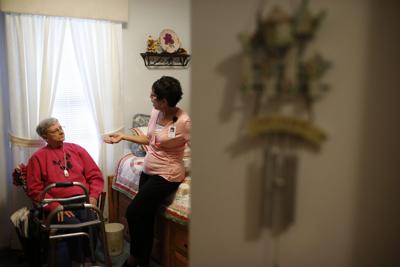The state’s Department of Health Services announced Wednesday that, beginning in the 2023 fiscal year, Medicaid will cover an average of 91% of the cost of care provided in nursing homes, up from 77% in the 2022 fiscal year.
“The people who work in and lead Wisconsin’s nursing homes are critical to ensuring quality care for residents across the state of Wisconsin,” DHS Secretary-designee Karen Timberlake said in a press release. “Our new rate setting model allows us to prioritize funding for direct care nursing and support increased wages for health care workers to ensure continuing high-quality care.”
The move comes as the state faces a major shortage of workers to provide this care, both in facilities like nursing homes and in the increasingly popular alternative, in-home care. More than a quarter of long-term caregiver jobs in Wisconsin are unfilled, according to an August report from a coalition of care providers. These jobs make up one of the fastest growing employment sectors in the state.
While industry advocates point to a variety of reasons for the shortage, including current workers leaving due to burnout, they say low Medicaid reimbursement rates don’t allow nursing homes or care agencies to offer the wages and benefits that can compete with other industries.
The average hourly wage for a Wisconsin certified nursing assistant, one of the most common jobs in nursing homes, was $16.28 in May 2021, according to the U.S. Bureau of Labor Statistics. The average wage for workers providing in-home care in Wisconsin in 2020 was $12.32 an hour, according to PHI, a think tank focused on elder care and disability services.
The shortage is only expected to worsen as the state’s population ages — increasing the number of people who need nursing care — and more people age out of the caregiving workforce. The number of Wisconsinites over 65 is expected to be 72% higher in 2040 than it was in 2015, according to Department of Administration projections.
In 2020, the Governor’s Task Force on Caregiving offered more than a dozen recommendations to address challenges facing the industry. Among them was “linking nursing home reimbursement rates to the actual cost of care.” In January, Gov. Tony Evers announced that he would increase the rates Medicaid pays to nursing homes and hospitals. According to the press release, from 2019 to 2023, the state is “investing” more than $500 million in payments and incentives to nursing homes and more than $275 million in payments and incentives to hospitals.
John Sauer is president and CEO of LeadingAge Wisconsin, a membership group representing nonprofit care providers. He said in the Wednesday announcement that DHS has “implemented bold steps to further invest in our state’s fragile nursing home system and has done so in a way that targets dollars where they are most desperately needed.” Such moves, he said, would help nursing home residents and staff alike.
“Our mission-driven providers are deeply appreciative of these efforts which appropriately allocate critically needed dollars for caregivers and other frontline support staff who are essential in meeting the needs of our skilled care residents.”
Rick Abrams, CEO of the Wisconsin Health Care Association, an industry advocacy group, called such rate increases “critical,” saying they would help nursing homes “ensure quality care addressing ongoing financial challenges, including increased operational costs due to COVID-19 and increased inflation.”
“It has been our priority to ensure a fair, equitable distribution of the historic funding increases included by the 2021-23 state budget,” Abrams said in the release. “We commend DHS for its collaborative approach to the nursing home rate setting process, and for implementing a rate plan that considers the diverse needs of providers across the state.”
The increase to the Medicaid rate follows the July announcement that the state would expand WisCaregivers, its free training program for certified nursing assistants, which places prospective CNAs in jobs in nursing homes during their training.



